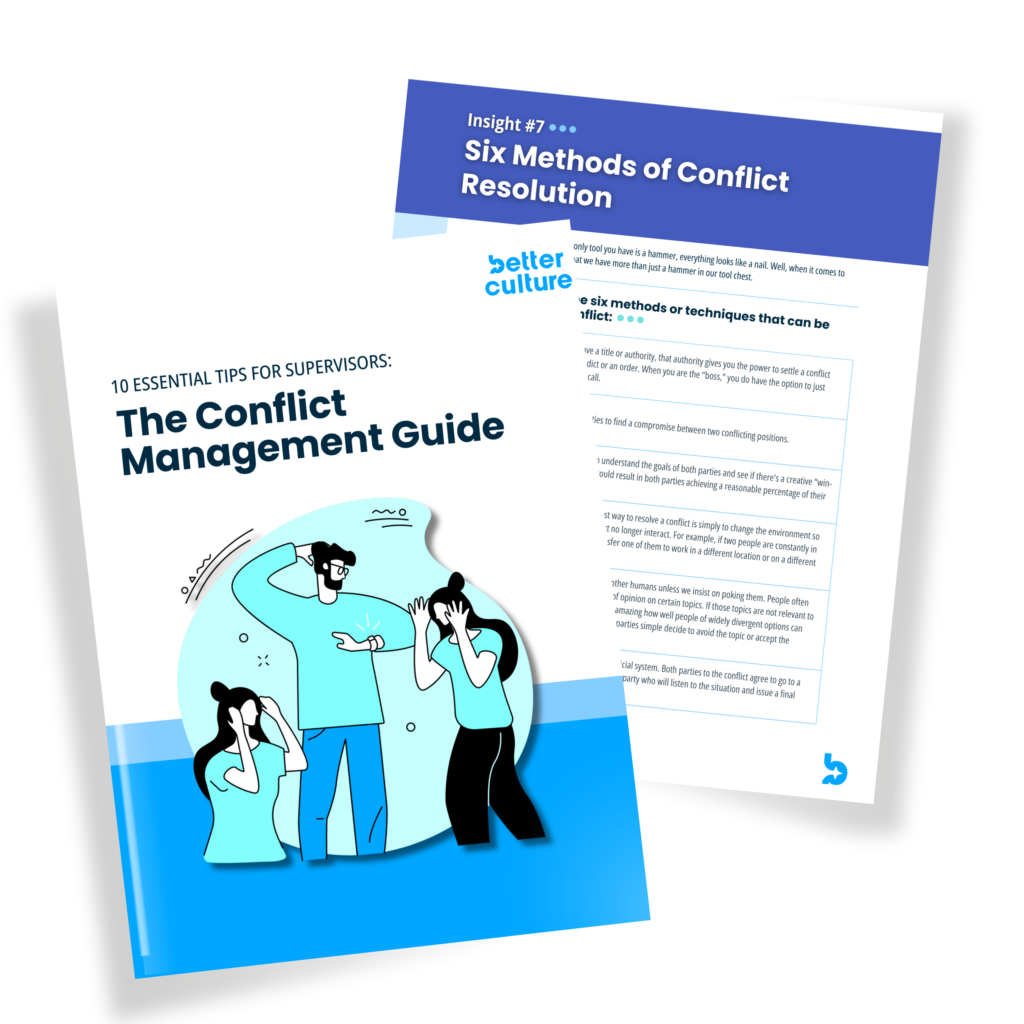Leadership. Is there a more over-hyped word in business? We doubt it. Yet for all the attention it gets, for all the books and speeches addressing the topic, inspired and effective leadership is still hard to find.
Many factors contribute to the elusiveness of the kind of leadership so many are seeking, including promoting the wrong people, focusing on short-term results over of long-term success, jumping from one trendy leadership fad to the next, and more.
Yet the most frequent problem is more basic. The largest obstacle to better leadership is a lack of clarity of thought on what it means to be a leader.
Leadership Roulette
Most lousy leaders don’t wake up in the morning and make a conscious decision to be a lousy leader. Almost no supervisor goes into work intending to do as much damage to the morale and culture as they can. The problem with most lousy leaders is they simply don’t see the damage they are causing (and the opportunities they are missing). For some leaders the ability to undermine trust, hurt feelings, bungle communication, stoke fear, or otherwise damage the work culture just seems to come naturally.
Now to be fair, we often find leaders who do the right thing – even the brilliant thing – yet lack consistency. The very next day they do…well, not the right thing. Many of these leaders are working from good instinct but mishandle opportunities because they lack a clear schema for viewing their role as a leader.
What is the cure for a lack of clear, consistent, guiding leadership principles? A clear mental model for what it means to lead.
The Schema for What it Means to be a Leader
Can you clearly articulate what it means to lead? For the vast majority of leaders, the unfortunate answer is ‘no.’ Don’t believe us? Check for yourself. Approach five experienced managers in different parts of your organization and simply ask them “What does it mean to be a leader in our organization?” We’ll wager dollars to donuts what you’ll hear: head-scratching, vague generalities, and little consensus.
The first step in mastering a thing is understanding it. The essence of leadership can be boiled down to seven core principles.
When you learn to bring these seven essential insights to life inside your business, you will have created one of the most valuable assets any business can have: a culture where your employees can grow and your business will thrive.
The Seven Principles of Leadership©
The primary influence for the founding of BetterCulture was a visionary leader named Kim Hoogeveen. Dr. Hoogeveen penned these Seven Principles of Leadership in 1991 when he became the founding president & CEO of an organization that became one of the most incredible workplace culture success stories in the US:
- An organization voted an unprecedented 5 consecutive times as the #1 Best Place to Work in its metropolitan area
- The largest center of its kind in the United States
Sustained financial success - A staff turnover rate one third the industry average
- Tremendous employer brand and blue sky
- And much more…
The simple, yet powerful, framework for building such a dominantly successful business and culture is contained in these seven elegantly simple principles (Download a printable version of the Seven Principles of Leadership©)
Leadership Principle #1: Leaders maintain a never-ending focus on mission, excellence, and culture.
A company’s mission sets the foundational purpose for a company. It provides an organizing focus that ultimately drives decisions and the allocation of resources. A mission should also inspire employees to understand their role in larger vision.
Most businesses claim excellence as their goal; few mean it, and fewer still achieve it. When we study those businesses that have achieved it, BetterCulture has usually found a strong leader who is not satisfied with the status quo; they are a relentless force striving for constant improvement. They can be impatient and uncompromising as they relentlessly push the organization’s capabilities toward an ever-growing vision. These unique individuals are driven to check things twice and never settle for close enough; and they strive to surround themselves with others who do the same thing.
The culture of a workgroup or company can be defined as the attitudes and behaviors a group of people come to expect from one another. Every workgroup and company will have a culture. The question is whether an organization is able to intentionally envision, create, and protect the culture they want or whether they have a culture that evolves randomly on its own. The former is far preferable to the latter.
The big three to always keep in view: Mission, Excellence, and Culture.
Leadership Principle #2: Leaders create an environment where staff feel proud of their company – and know that their company is proud of them.
Employee pride is the single most undervalued (and unrecognized) factor impacting the quality of your culture and the ultimate success of your enterprise. When pride for the company is high, employee performance surges. When employees feel appreciated and valued by their company, again performance improves.
Almost no supervisor gets up in the morning with a desire to damage employee pride in the company or to convey the message that employees are not appreciated. Nobody argues against this idea. Yet, too few supervisors can say they spend a meaningful amount of time and energy building pride and showing appreciation.
Unfortunately, many supervisors unintentionally walk right by opportunities to build pride and effectively show appreciation every day. They flat-out don’t see the opportunities in front of them. Poor leadership is this area is not an act of commission; it is a big problem of omission. If you want to become more effective as a leader, this area is a wonderful place to start.
Leadership Principle #3: Leaders work hard to help employees be successful at work and in life.
When we first created this principle, most companies were committed to helping employees be successful at work, but it was only the outlier company that had any sense of what we meant by helping employees to be more successful in life. Today, things are moving in a better direction.
The best employees today are not searching for that tired, old bromide: work-life balance – as if they are on a teeter-totter where anything that advances one must come out the hide of the other. No, what today’s workforce wants is work-life integration, where their work is an important part of their life.
Employees should understand that sometimes work will need to impinge on their life. And employers should acknowledge that sometimes an employee’s life will impinge on their work. When organizations truly embrace this principle, they find that work-life and personal-life don’t pull in opposite directions – they enrich one another.
Leadership Principle #4: Leaders protect the right of good staff to work with good staff.
What could be more demotivating to a great employee than having to work day-after-day, side-by-side with a colleague who is either incompetent or unpleasant? Not much. Yet far too many “leaders” decide every day to tolerate consistent negativity or underperformance from members of their team.
If a leader allows this pattern to continue unchecked, do you think it will be the great employee or the problem employee who will still be working there 2 years later? It sure won’t be the great employee, and that’s a BIG problem.
There are many reasons this unfortunate dynamic is so common, including a lack of awareness of the issue, fear of conflict, misguided staff discipline practices (or lack thereof), or leaders simply not knowing how to address to problem.
But leaders neglect this responsibility at their own peril. Few things will better propel the long-term success of your business than protecting the right of good staff to work with good staff.
Leadership Principle #5: Leaders encourage and promote open discussion and analysis as a predicate to decision making.
Employees today increasingly care about the process their company uses to make decisions. Good leaders are wise to offer employees opportunity for input when it’s possible, and when it’s not, take care to communicate, explain, and even teach after the fact.
Involving and educating employees regarding company decisions has four big benefits:
- Employees feel valued and appreciated when leaders ask them for input or take time to explain their actions. And that is something you should want (see principle #2).
- When leaders let employees see the information and processes that go into making complex organizational decisions, they provide employees with a significant opportunity to learn and grow. You want this too (see principle #3).
- If leaders solicit and consider employees’ ideas, on occasion they will make a better decision. And this is a good thing for…obvious reasons.
- When employees understand the rationale behind decisions, they are better able to implement plans because of their improved ability to distinguish between anticipated and unanticipated bumps along the way.
Leadership Principle #6: Leaders deal effectively with conflict.
The number one reason new supervisors, who otherwise would have been successful, fail is an inability or unwillingness to address conflict. This is not too surprising given 1) conflict is inevitable for those who accept a leadership position, 2) many good and talented people are not naturally suited to handle conflict well, and 3) seldom are new supervisors given worthwhile training on how to best address the different types of conflict they are likely to encounter.
Note that Principle #6 does not say “effectively eliminate conflict.” Great work groups are not devoid of conflict; workgroups entirely devoid of conflict are almost always also devoid of passion, innovation, and excellence.
Great workgroups have a leader who has created a work culture where intellectual conflict is welcomed (even celebrated), but personal conflict is promptly addressed and eliminated.
Leadership Principle #7: Leaders encourage others to enjoy their work.
Work is not, and should not be considered, the opposite of fun. The best leaders embrace the idea that teams can work incredibly hard and create laughter, spontaneity, and joy at the same time.
It turns out that measuring smiles and laughter is a pretty effective proxy for evaluating the health of a culture or the engagement of employees.
Simple to Understand. Challenging to Live.
As you review the principles above, you will see that they are simple to understand. If you have realized that, then you have acquired a key insight into leadership. In many aspects of life and business, complexity is positively correlated with importance. This is not so when it comes to leadership.
The most important insights in leadership are easy to understand. The challenge is not comprehension. Then challenge of leadership is having the sight and discipline to live up to these principles and to make them come to life for your employees every day.
Do that, and you are well on your way to creating a better culture and a better business.



